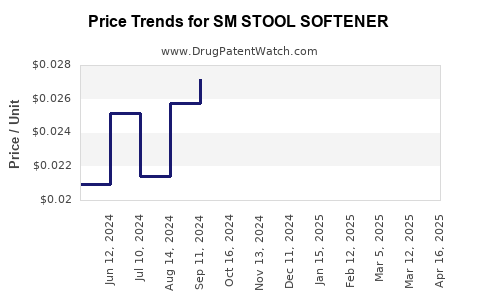Drug Price Trends for SM STOOL SOFTENER
✉ Email this page to a colleague

Average Pharmacy Cost for SM STOOL SOFTENER
| Drug Name | NDC | Price/Unit ($) | Unit | Date |
|---|---|---|---|---|
| SM STOOL SOFTENER 100 MG TAB | 49348-0167-10 | 0.03829 | EACH | 2024-11-20 |
| SM STOOL SOFTENER 100 MG SFTGL | 70677-0034-01 | 0.02124 | EACH | 2024-11-20 |
| SM STOOL SOFTENER-LAXATIVE TAB | 70677-0083-01 | 0.02864 | EACH | 2024-11-20 |
| SM STOOL SOFTENER 100 MG SFTGL | 70677-0034-02 | 0.02124 | EACH | 2024-11-20 |
| SM STOOL SOFTENER 100 MG SFTGL | 70677-0082-01 | 0.02124 | EACH | 2024-11-20 |
| SM STOOL SOFTENER 100 MG TAB | 49348-0167-10 | 0.03905 | EACH | 2024-10-23 |
| SM STOOL SOFTENER 100 MG SFTGL | 70677-0034-01 | 0.02814 | EACH | 2024-10-23 |
| >Drug Name | >NDC | >Price/Unit ($) | >Unit | >Date |


